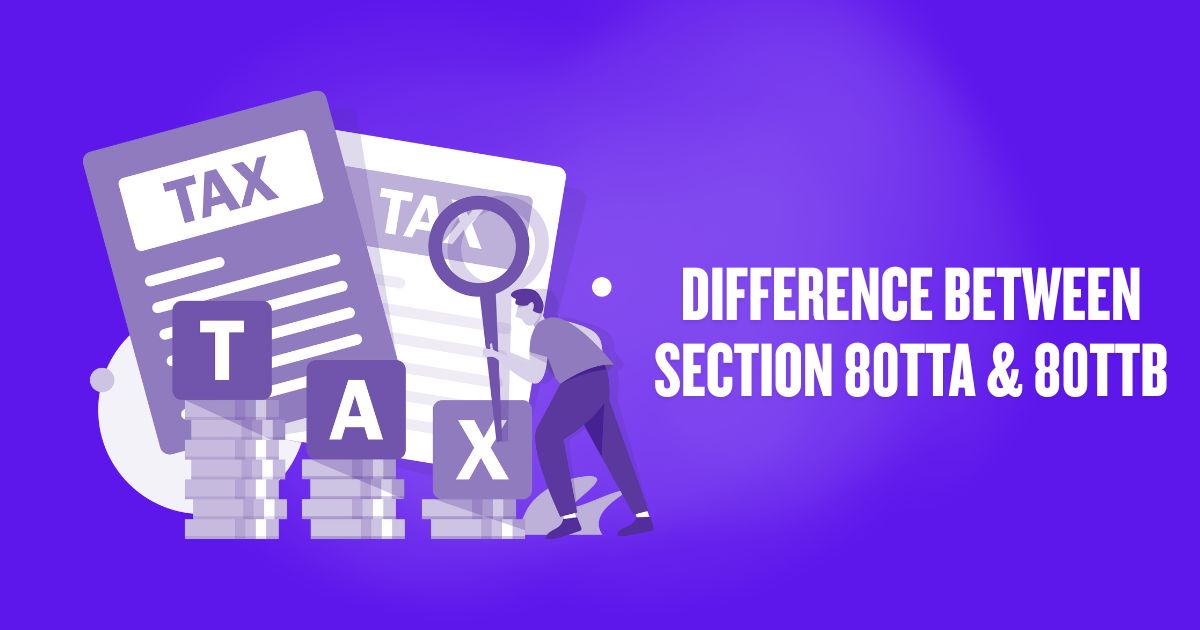Taxes often feel like a puzzle, especially when it comes to deductions. Among the many useful deductions in the Income Tax Act, Section 80TTA and Section 80TTB stand out for their focus on interest income. Both provisions reduce taxable income but apply to different groups of people. Understanding the fine distinctions between them can help you plan better and save more.

What is Section 80TTA?
Section 80TTA provides tax relief to individual taxpayers below 60 years and Hindu Undivided Families (HUFs). It allows deductions on interest earned from savings accounts, making it one of the key provisions highlighting HUF & its tax advantages.
Key Features:
- Eligibility: Individuals (except senior citizens) and HUFs.
- Deduction Limit: Up to ₹10,000 in a financial year.
- Sources of Income Covered: Interest earned from savings accounts in banks, post offices, or cooperative societies.
For instance, if someone earned ₹9,500 as savings account interest during the year, the entire amount can be claimed as a deduction under this section.
What is Section 80TTB?
Introduced in Budget 2018, Section 80 TTB was designed exclusively for senior citizens to give them higher tax relief on interest income, considering their greater dependence on secure investments.
Key Features:
- Eligibility: Resident senior citizens aged 60 years and above.
- Deduction Limit: Up to ₹50,000 in a financial year.
- Sources of income covered: Interest from savings accounts, fixed deposits (FDs), recurring deposits (RDs), and other specified deposits in banks, cooperative banks, and post offices.
This provision replaced the applicability of Section 80TTA for senior citizens, offering them a wider scope of benefits.
Section 80TTA vs Section 80TTB: The Differences
While both sections grant relief on interest income, they differ in eligibility, limits, and the type of deposits covered.
| Particulars | Section 80TTA | Section 80TTB |
| Who can claim? | Individuals (except senior citizens) and HUFs | Resident senior citizens (60 years and above) |
| Deduction limit | Up to ₹10,000 | Up to ₹50,000 |
| Income covered | Savings account interest only | Interest from savings accounts, FDs, RDs, and other deposits |
| Applicable from | FY 2012-13 | FY 2018-19 |
This makes Section 80TTB much broader in scope, offering a meaningful tax advantage to seniors who rely heavily on fixed-income sources.
Illustration on Tax Savings for Senior Citizens
Consider a senior citizen with the following income during a financial year:
- Savings interest: ₹5,000
- FD interest: ₹2,00,000
- Other income: ₹1,50,000
Without Section 80 TTB
Their gross income = ₹3,55,000.
Without any deduction on FD interest, only the savings account interest of ₹5,000 could be considered under Section 80TTA (if they were not a senior citizen).
Taxable income = ₹3,50,000.
With Section 80TTB
Deduction allowed = ₹50,000 (covering savings and FD interest).
Taxable income = ₹3,05,000.
Here, by availing Section 80TTB, the individual saved tax on an additional ₹45,000 of income. If the tax slab rate were 10%, that translates into ₹4,500 saved. Over multiple years, this relief makes a significant difference to retirement planning.
How to Claim Deduction Under Section 80TTA and Section 80TTB
- Collect interest certificates from banks, post offices, or cooperative societies.
- Add up all eligible interest income during the financial year.
- Claim the deduction while filing your Income Tax Return (ITR).
- For senior citizens, ensure you use Section 80TTB and not Section 80TTA, as the latter no longer applies to them.
Importance of These Provisions in Financial Planning
Both sections are valuable tools to lower taxable income and encourage safe investments. Younger individuals benefit from Section 80TTA, which rewards the habit of maintaining savings. Senior citizens, on the other hand, gain from Section 80 TTB, as it covers a wider pool of deposit interest, directly supporting their financial security in retirement years.
When integrated with long-term strategies like pension funds, insurance-linked savings plans, or fixed-income investments, these provisions allow taxpayers to balance protection, growth, and tax savings.
Conclusion
The difference between Section 80TTA and Section 80TTB lies mainly in who can claim them and the deduction limits. While 80TTA supports younger taxpayers and HUFs with up to ₹10,000 relief, 80TTB empowers senior citizens with a more generous ₹50,000 deduction across multiple deposit types.
By knowing which section applies to you, you can avoid missed opportunities and ensure smarter tax planning. Thoughtful use of these provisions, combined with disciplined investments like insurance-backed savings plans, can help secure a stable financial future.
Aviva India offers financial solutions that not only protect your loved ones but also align with your long-term savings and tax planning goals. Choosing the right mix of products and deductions can transform routine tax filing into a meaningful step toward financial independence.